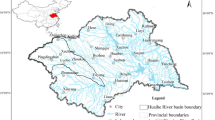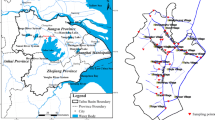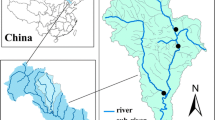Abstract
The contribution of non-point source pollution (NPS) to the contamination of surface water is an issue of growing concern. Non-point source (NPS) pollutants are of various types and altered by several site-specific factors making them difficult to control due to complex uncertainties involve in their behavior. Kelantan River basin, Malaysia is a tropical catchment receiving heavy monsoon rainfall coupled with intense land use/land cover (LULC) changes making the area consistently flood prone thereby deteriorating the surface water quality in the area. This study was conducted to determine the spatio-temporal variation of NPS pollutant loads among different LULC changes and to establish a NPS pollutant loads relationships among LULC conditions and sub-basins in each catchment. Four pollutants parameters such as total suspended solids (TSS), total phosphorus (TP), total nitrogen (TN) and ammonia nitrogen (AN) were chosen with their corresponding event mean concentration values (EMC). Soil map and LULC change maps corresponding to 1984, 2002 and 2013 were used for the calculation of runoff and NPS pollutant loads using numeric integration in a GIS environment. Analysis of Variance (ANOVA) was conducted for the comparison of NPS pollutant loads among the three LULC conditions used and the sub-basins in each catchment. The results showed that the spatio-temporal variation of pollutant loads in almost all the catchments increased with changes in LULC condition as one moves from 1984 to 2013, with 2013 LULC condition found as the dominant in almost all cases. NPS pollutant loads among different LULC changes also increased with changes in LULC condition from 1984 to 2013. While urbanization was found to be the dominant LULC change with the highest pollutant load in all the catchments. Results from ANOVA reveals that statistically most significant (p < 0.05) pollutant loads were obtained from 2013 LULC conditions, while statistically least significant (p < 0.05) pollutant loads were obtained under 1984 LULC condition. This reveals the clear effect of LULC changes on NPS pollution. The findings of this study may be useful to water resource planners in controlling water pollution for future planning.







Similar content being viewed by others
References
Adams BJ, Papa F (2001) Urban storm water management planning with analytical probabilistic models. Can J Civ Eng 28:545
Adnan NA, Atkinson PM (2011) Exploring the impact of climate and land use changes on streamflow trends in a monsoon catchment. Int J Climatol 31:815–831. https://doi.org/10.1002/joc.2112
Bai X, Ma KM, Yang L, Zhang XL (2008) Simulating the impacts of land-use changes on non-point source pollution in Lugu Lake watershed. Int J Sust Dev World 15:18–27. https://doi.org/10.1080/13504500809469764
Bhaduri B, Harbor J, Engel B, Grove M (2000) Assessing watershed-scale, long-term hydrologic impacts of land-use change using a GIS-NPS model. J Environ Manag 26:643–658
Chow MF, Yusop Z (2006) Storm runoff quality in a residential catchment in Malaysia. J Environ Hydrol 14:1–7
Chow MF, Yusop Z, Mohamed M (2011) Quality and first flush analysis of storm water runoff from a tropical commercial catchment. Water Sci Technol 63:1211–1216. https://doi.org/10.2166/wst.2011.360
DID (Drainage and Irrigation Department) (2000) Annual flood report of DID for Peninsular Malaysia. Kuala Lumpur
DID (Drainage and Irrigation Department) (2012) Urban Stormwater Management Manual for Malaysia
Eisakhani M, Pauzi A, Karim O, Malakahmad A, Kutty SRM, Isa MH (2009) GIS-based non-point Sources of pollution simulation in Cameron Highlands, Malaysia. Int J Civ Environ Eng 3:3–7
Engel B (2001) L-THIA NPS Long-Term Hydrologic Impact Assessment and Non-Point Source Pollutant Model, version 2.1. Purdue University and US Environmental Protection Agency
Engel BA, Choi JY, Harbor J, Pandey S (2003) Web-based DSS for hydrologic impact evaluation of small watershed land use changes. Comput Electron Agric 39:241–249
Fohrer N, Haverkamp S, Eckhardt K, Frede HG (2001) Hydrologic response to land use changes on the catchment scale. Phys Chem Earth Pt B 26:577–582. https://doi.org/10.1016/S1464-1909(01)00052-1
Girmay G, Singh BR, Nyssen J, Borrosen T (2009) Runoff and sediment-associated nutrient losses under different land uses in Tigray. Northern Ethiopia. J Hydrol. 376:70–80. https://doi.org/10.1016/j.jhydrol.2009.07.066
Huber WC (1993) Contaminant transport in surface water. In: Handbook of hydrology. Springer, Dordrecht, pp 11–14
Jamaliah J (2007) Emerging Trends of Urbanization in Malaysia. J Dept Stat, Malaysia. 1:43–54. http://www.statistics.gov.my/eng/images/stories/files/journalDOSM/V104ArticleJamaliah.pdf
Li T, Bai F, Han P, Zhang Y (2016) Non-point source pollutant load variation in rapid urbanization areas by remote sensing, GIS and the L-THIA Model: a Case in Bao’an District, Shenzhen, China. Environ Manag 58:873–888. https://doi.org/10.1007/s00267-016-0743-x
Meals DW, Richards RP, Steven AD (2013) Pollutant load estimation for water quality monitoring projects. National Nonpoint Source Monitoring Program, pp. 1–21
Moriasi DN, Arnold JG, Van Liew MW, Bingner RL, Harmel RD, Veith TL (2007) Model evaluation guidelines for systematic quantification of accuracy in watershed simulations. Trans ASABE 50:885–900
Nash JE, Sutcliffe JV (1970) River flow forecasting through conceptual models part I—a discussion of principles. J Hydrol 10:282–290. https://doi.org/10.1016/0022-1694(70)90255-6
Nazahiyah R, Yusop Z, Abustan I (2007) Storm water quality and pollution loading from an urban residential catchment in Johor, Malaysia. Water Sci Technol 56:1–9. https://doi.org/10.2166/wst.2007.692
Novotny V (2003) Water quality: diffuse pollution and watershed management. Wiley, Hoboken
Ozdemir H, Elbaşı E (2015) Benchmarking land use change impacts on direct runoff in ungauged urban watersheds. Phys Chem Earth Pt A/B/C 79–82:100–107. https://doi.org/10.1016/j.pce.2014.08.001
Rossi L, Krejci V, Rauch W, Kreikenbaum S, Fankhauser R, Gujer W (2005) Stochastic modeling of total suspended solids (TSS) in urban areas during rain events. Water Res 39:4188–4196. https://doi.org/10.1016/j.watres.2005.07.041
Shen Z, Hong Q, Yu H, Niu J (2010) Parameter uncertainty analysis of non-point source pollution from different land use types. Sci Total Environ 408:1971–1978. https://doi.org/10.1016/j.scitotenv.2009.12.007
Shen Z, Liao Q, Hong Q, Gong Y (2012) An overview of research on agricultural non-point source pollution modelling in China. Sep Purif Technol 84:104–111. https://doi.org/10.1016/j.seppur.2011.01.018
Thanapakpawin P, Richey J, Thomas D, Rodda S, Campbell B, Logsdon M (2007) Effects of landuse change on the hydrologic regime of the Mae Chaem river basin, (NW) Thailand. J Hydrol 334:215–230. https://doi.org/10.1016/j.jhydrol.2006.10.012
Tong STY, Chen W (2002) Modeling the relationship between land use and surface water quality. J Environ Manag 66:377–393. https://doi.org/10.1006/jema.2002.0593
United States Environmental Protection Agency (2009) National Water Quality Inventory: report to Congress. Water, 1:43. http://www.epa.gov/owow/305b/2004report/
Wan I (1996) Urban growth determinants for the state of Kelantano of the state’s policy makers. Penerbitan Akademik Fakulti Kejuruteraan dan Sains Geoinformasi. Buletin Ukur 7:176–189
Wang S, Wang S (2013) Land use/land cover change and their effects on landscape patterns in the Yanqi Basin, Xinjiang (China). Environ Monit Assess 185:9729–9742. https://doi.org/10.1007/s10661-013-3286-0
Yusop Z, Tan LW, Ujang Z, Mohamed M, Nasir KA (2005) Runoff quality and pollution loadings from a tropical urban catchment. Water Sci Technol 52:125–132
Zaimes GN, Schultz RC, Isenhart TM (2008) Total phosphorus concentrations and compaction in riparian areas under different riparian land-uses of Iowa. Agric Ecosyst Environ 127:22–30. https://doi.org/10.1016/j.agee.2008.02.008
Zhan X, Huang ML (2004) ArcCN-runoff: an ArcGIS tool for generating curve number and runoff maps. Environ Model Softw 19:875–879. https://doi.org/10.1016/j.envsoft.2004.03.001
Zhang J, Shen T, Liu M, Wan Y, Liu J, Li J (2011) Research on non-point source pollution spatial distribution of Qingdao based on L-THIA model. Math Comput Model 54:1151–1159. https://doi.org/10.1016/j.mcm.2010.11.048
Acknowledgements
This research was funded by the Fundamental Research Grant Scheme (FRGS) 2015-1 from the Ministry of Higher Education (MOHE), Malaysia. The authors wish to thank Department of Irrigation and Drainage (DID) Ampang, Malaysia for the hydrological data and Department of Agriculture, Malaysia for the soil map as well as land use maps.
Author information
Authors and Affiliations
Corresponding author
Ethics declarations
Conflict of interest
On behalf of all authors, the corresponding author states that there is no conflict of interest. Authors further declare that there is no financial or personal relationship with a third party whose interests could be positively or negatively influenced by this article’s content.
Electronic supplementary material
Below is the link to the electronic supplementary material.
Rights and permissions
About this article
Cite this article
Abdulkareem, J.H., Sulaiman, W.N.A., Pradhan, B. et al. Long-Term Hydrologic Impact Assessment of Non-point Source Pollution Measured Through Land Use/Land Cover (LULC) Changes in a Tropical Complex Catchment. Earth Syst Environ 2, 67–84 (2018). https://doi.org/10.1007/s41748-018-0042-1
Received:
Accepted:
Published:
Issue Date:
DOI: https://doi.org/10.1007/s41748-018-0042-1




